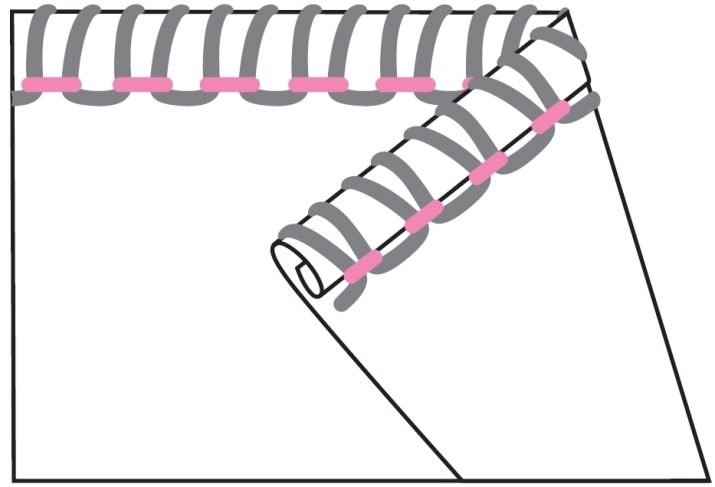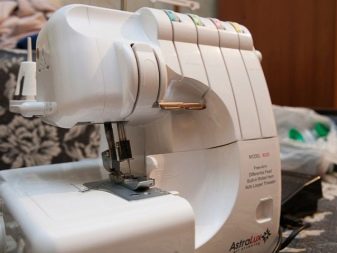Overlock is a sewing machine with which to cut sections of various fabrics. Thanks to the overlock, the edges of the materials do not crumble and keep a neat appearance for a long time. Nevertheless, edge machining is far from the only possibility of this machine. Overlock functions also include role seam. This seam can be laid on all modern models of sewing machines. Getting started, you only need to deal with a number of features.

What is a role seam?
In different sources there are several names of this seam: hem, roller, optics. The edge sealed with a roller seam will look like a stitch twisted inward. A similar result can be achieved through the necessary actions with overlock tensioners. A roller seam is a tight stitch that runs at the very edge of the product, with frequent repetition of the stitch.

Features of role stitching:
- the edge of the product becomes stronger;
- threading kapron fishing line increases the number of folds on the frills;
- when marking the petticoat, the hem becomes more voluminous;
- allows you to gracefully bend the edges of the fabric without stretching, if you set the correct settings;
- smooth union, if you first do the overlay, and then fasten the parts together on the same gap;
- the joint can also be decorative.


Basically, a roller seam is performed on clothes with frills and ruffles, for example, dance or carnival costumes. It can also be used to work with tulle and knitwear.
Main types
Consider the types of folding seams, distinguished by the number of coils in the work.

Double thread
Used on materials that need to be handled with extreme care, where you need to reduce the number of threads. In the process, the needle and looper from the bottom are involved. This view cannot be done on ordinary models, only with the help of overlocks with converters. Needles that do not participate in the seam are blocked by the converter to release the needles needed for the job.

Three strand
It is the optimal alternative that is available on all overlocks, since three-strand is a standard seam. Thanks to it, you can overcast the edges of soft, opaque products. To create additional decor, you can choose a thread that is different from the fabric in color.

Four-thread
To do this, you need to use two hooks and two needles. It is much stronger and denser, although outwardly no different from a three-strand seam. It is advised to use when processing the hem of long dance dresses or skirtsto maintain material durability and a neat appearance.

Five thread
In fact, this is a clutch of two-thread and three-thread seams, in the center of which there is a connected one-thread seam. Great for high-density materials such as jeans.

Thread Tension Levels
To begin sewing with a role seam, it is important to consider the level of thread tension. By adjusting the tension, stitches of various sizes and shapes come out. There is a special wheel on the overlock that performs this function. There are overlock models that include built-in adjustment. She herself adjusts the necessary values, taking into account the required seam.
In standard models, the wheels are located on a plane or on one of the rods, which contributes to the implementation of the same tension of all threads.

How to adjust on overlock?
After you have reconfigured the overlock to the hem, take the first line to check the thread tension. Take a closer look at the accuracy of the role seam. If the stitches are even and do not collect the fabric, then in this case the thread tension is left unchanged.
Due to the fact that the knife of the machine is not available, it remains to correctly place the fabric on the working plane. Align it in accordance with the right edge of the foot. You can adjust by observing the mark, which is located directly under the foot.

We sew one more line. As a result, a narrow and beautiful role seam with a width of about 2 mm from the edge of the product should come out. The following reasons will indicate that it is necessary to change the thread tension:
- the loops are not tight enough, loose and easily loosen due to the lack of proper tension;
- the thread gets tangled and sews different stitches.

In this situation, you can add tension to the threads of the machine, and then sew a few more stitches. Carefully monitor that the fabric does not wrinkle and does not collect at the edges. The elasticity of the product does not depend on the seam; proper adjustment allows the material to stretch well. The seam protects the fabric from quick shedding and looks quite attractive, so that another trim trim is not needed.
Making neat seams will not be a problem, as it might seem at first glance. It is only necessary to take into account all the recommendations that have been listed above and monitor the accuracy of the output line.
Poor quality stitches can indicate that you need to check how correctly the thread is threaded into the overlock. If everything is no problem, then check the thread tension.

Instruction manual
Consider the models AstraLux 820D and Family ML645D. There will be no comparison of different cars - the setting is practically no different.
- Lower all needles to the lowest possible position.
- Move the lower knife. Open the left panel to access the hidden device of the machine. Here is the part that disconnects the knife. Press it, then turn the knife in its direction, lowering it below.Do not overdo it - the part can easily be pulled back when observing the correct manipulations.
- Locate the typewriter switch Usually it is set to the standard stitch. Switch to the "R" position. To do this, click on the part located next to the lever. After setting the lever to the upper position, the overlock seam will become extremely narrow.
- Replace the panel. Now you can set the stitch length switch to the “R” position.
- Thread the threads depending on the seam frequency.
The AstraLux model does not need to change the needle plate.


Recommendations for a two-thread role seam:
- it is necessary to remove the thread of the upper converter;
- install the upper looper converter;
- the tip of the converter should fall into the looper ear;
- the role of the converter is that it feeds the lower thread.
Now it remains to fill the fabric and start overcasting.
To complete the seam requires patience and accuracy, as the work will be painstaking and not easy. The smallest damage will lead to the fact that the appearance of the thing deteriorates and will have to start again.

Useful Tips
- Check the operation of all parts: raising the foot, rotating the handwheel.
- Remove the left needle if you are not going to make a four-thread seam.
- You can customize the product according to how you want it to look. It is not always possible to get the correct settings from the instructions. In most cases, the user will have to select the correct parameters. You can see the information on special forums or sites where other craftswomen share their knowledge in detail. You can check your settings on a small piece of fabric.
- When processing, try to hold the fabric so that it does not slip.


Try not to rush if there is not enough experience when working with a roller seam.
See how to set up a role seam on the overlock in the next video.










